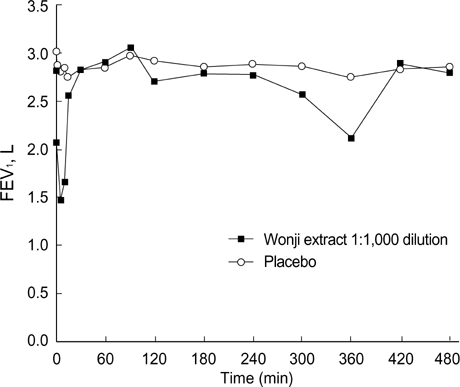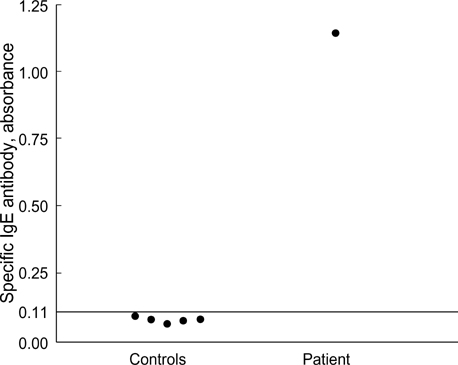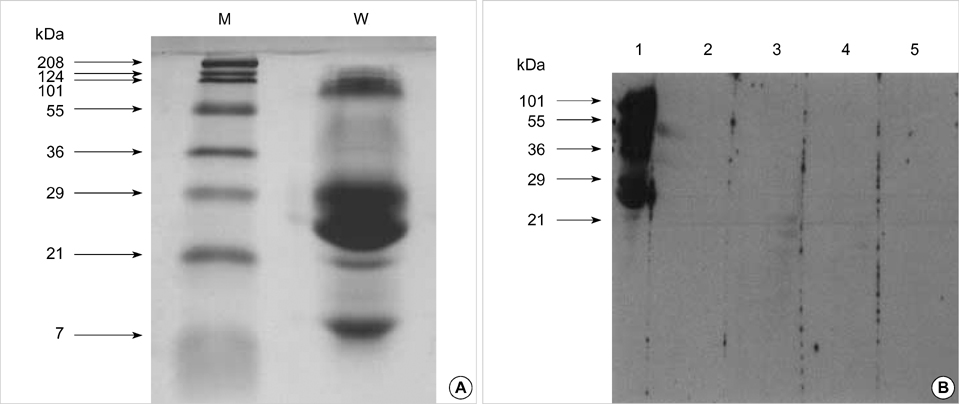J Korean Med Sci.
2005 Feb;20(1):46-49. 10.3346/jkms.2005.20.1.46.
Occupational Asthma and Rhinitis Induced by a Herbal Medicine, Wonji (Polygala tenuifolia)
- Affiliations
-
- 1Department of Internal Medicine, Seoul National University College of Medicine, Korea. youyoung@plaza.snu.ac.kr
- 2Institute of Allergy and Clinical Immunology, Seoul National University Medical Research Center, Seoul, Korea.
- KMID: 1781723
- DOI: http://doi.org/10.3346/jkms.2005.20.1.46
Abstract
- Occupational asthma is induced by many agents, including herbal materials, that are exposed in working places. Although there are a few case reports for occupational allergy induced by herbal materials, there is none for that induced by Wonji (Polygala tenuifolia). This study was conducted to evaluate clinical characteristics and immunologic mechanism of Wonji-induced asthma in a exposed-worker. A patient who complained of asthma and rhinitis symptoms, and who had worked in a herbal manufacturing factory for 8 yr, underwent a skin prick test with crude extract of Wonji under the impression of occupational asthma induced by the agent. The patient had a strong positive response to the extract on the skin prick test. Allergen bronchial challenge to the extract demonstrated a typical dual response. Serum specific IgE level to the extract was higher in the patient than in healthy controls, and ELISA inhibition test revealed complete inhibition of IgE binding with the extract, but no inhibition with Der p 2 or mugwort extracts. Six IgE binding components to the extract (10, 25, 28, 36, 50, and 90 kDa) were detected using SDS-PAGE and immunoblot analysis. These findings suggest that Polygala tenuifolia, a herbal material, can induce IgE-mediated bronchoconstriction in exposed workers.
Keyword
MeSH Terms
-
Allergens
Asthma/*chemically induced
Dose-Response Relationship, Drug
Electrophoresis, Polyacrylamide Gel
Enzyme-Linked Immunosorbent Assay
Humans
Immunoblotting
Immunoglobulin E/chemistry
Male
*Medicine, Herbal
Middle Aged
Occupational Exposure
Pollen/chemistry
Polygala/metabolism
Protein Binding
Research Support, Non-U.S. Gov't
Rhinitis/*chemically induced
Time Factors
Figure
Reference
-
1. Park HS, Kim MJ, Moon HB. Occupational asthma caused by two herb materials, Dioscorea batatas and Pinellia ternata. Clin Exp Allergy. 1994; 24:575–581.
Article2. Lee SK, Cho HK, Cho SH, Kim SS, Nahm DH, Park HS. Occupational asthma and rhinitis caused by multiple herbal agents in a pharmacist. Ann Allergy Asthma Immunol. 2001; 86:469–474.
Article3. Kim SH, Jeong H, Kim YK, Cho SH, Min KU, Kim YY. IgE-mediated occupational asthma induced by herbal medicine, Banha (Pinellia ternate). Clin Exp Allergy. 2001; 31:779–781.4. Cartier A, Malo JL, Labrecque M. Occupational asthma due to liquorice roots. Allergy. 2002; 57:863.
Article5. Subiza J, Subiza JL, Escribano PM, Hinojosa M, Garcia R, Jerez M, Subiza E. Occupational asthma caused by Brazil ginseng dust. J Allergy Clin Immunol. 1991; 88:731–736.
Article6. Kim YK, Son JW, Kim HY, Park HS, Lee MH, Cho SH, Min KU, Kim YY. New occupational allergen in citrus farmers: citrus red mite (Panonychus citri). Ann Allergy Asthma Immunol. 1999; 82:223–228.
Article7. Matte TD, Hoffman RE, Rosennman KD, Stanbury M. Surveillance of occupational asthma under the SENSOR model. Chest. 1990; 98:Suppl. 173S–178S.
Article8. Malo JL, Ghezzo H, L'Archeveque J, Lagier F, Perrin B, Cartier A. Is the clinical history a satisfactory means of diagnosing occupational asthma? Am Rev Respir Dis. 1991; 143:528–532.
Article9. Cockcroft DW, Murdock KY, Kirby J, Hargreave F. Prediction of airway responsiveness to allergen from skin sensitivity to allergen and airway responsiveness to histamine. Am Rev Respir Dis. 1987; 135:264–267.10. Malo JL, Cartier A, L'Archeveque J, Ghezzo H, Lagier F, Trudeau C, Dolovich J. Prevalence of occupational asthma and immunologic sensitization to psyllium among health personnel in chronic care hospitals. Am Rev Respir Dis. 1990; 142:1359–1366.
Article11. Wild LG, Lopez M. Occupational asthma caused by high-molecular-weight substances. Immunol Allergy Clin North Am. 2003; 23:235–250.
Article12. Milton DK, Solomon GM, Rosiello RA, Herrick RF. Risk and incidence of asthma attributable to occupational exposure among HMO members. Am J Ind Med. 1998; 33:1–10.
Article13. Burge PS, Edge G, O'Brien IM, Harries MG, Hawkins R, Pepys J. Occupational asthma in a research centre breeding locusts. Clin Allergy. 1980; 10:355–363.
Article14. Herxheimer H. Skin sensitivity to flour in baker's apprentices. Lancet. 1967; 1:83–84.
Article15. Block G, Tse KS, Kijek K, Chan H, Chan-Yeung M. Baker's asthma: clinical and immunological studies. Clin Allergy. 1983; 13:359–370.
Article16. Fish JE. Occupational asthma and rhinoconjunctivitis induced by natural rubber latex exposure. J Allergy Clin Immunol. 2002; 110:Suppl 2. S75–S81.
Article
- Full Text Links
- Actions
-
Cited
- CITED
-
- Close
- Share
- Similar articles
-
- Anti-ischemic Effect of Polygala Tenuifolia in Isolated Rat Heart
- A Case of Occupational Asthma and Rhinitis Induced by Ethylene Bis-stearamide
- Occupational Asthma Induced by the Reactive Dye Synozol Red-K 3BS
- Occupational asthma caused by inhalation of bovine serum albumin powder
- A case of cobalt-induced occupational asthma





